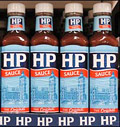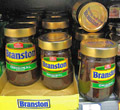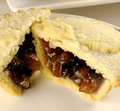acquired tastes
| | ||

|
Marmite I have to start with Marmite. Marmite is a yeast extract spread and is both strong tasting and salty. To say it is an acquired taste is something of an understatement. If you've never tasted Marmite it is very hard to describe but if you can imagine what condensed soy sauce might taste like then you're half way there. I have seen TV programs where they offer Marmite to foreigners and many look like they've been poisoned when they taste it. But it's not even universally liked in England. The makers of Marmite ran some bold adverts on TV where someone forces himself to drink sour milk to try and get the taste of accidentally eaten Marmite out of his mouth. You either love it or hate it is the theme of the adverts and that does seem to be true. I'm a bit of a heretic here because, although I do like Marmite, I actually prefer the Australian version called Vegemite. |
|
| | ||

|
brown sauce Tomato ketchup is known and loved world wide. Not so its brown cousin. The most famous (and best) brand is HP Sauce which has been produced since 1899. The "HP" in the name refers to the British Houses of Parliament and the sauce is said to get its name after being used in the restaurant there. The sauce is dark brown and has the classic sweet and sour taste of a table sauce. It is based on malt vinegar thickened and flavoured with tomatoes, molasses, dates, tamarind and spices. Although the manufacturer (these days the brand is owned by Heinz) encourages us to use it to liven up all sorts of foods its traditional home is on the side of a plate containing a Full English Breakfast. |
|
| | ||

|
Branston pickle Branston Pickle is the brand name of Britain's best selling chutney. Despite its name it is really a chutney because the ingredients are cooked together and then bottled rather than the fruit or vegetables being preserved in vinegar or oil as a true pickle would be. The style of the chutney is a direct descendent of the chatni recipes brought back to Britain from India by former colonial personnel of the British Empire. The ingredients are vegetables (carrots, rutabaga/swede, onions, cauliflower, marrow, gherkins) and fruit (dates, apples) cooked in a thickened sauce of sugar, vinegar, salt and spices. Branston Pickle is thick, sticky and dark brown in colour. If you are used to your chutneys and relishes being mild, sweet and just slightly tangy then Branston Pickle will probably make your eyes water. The taste is salty and sweet with a strong vinegar punch. It is a common constituent of a Ploughman's Lunch and essential in 'cheese and pickle' sandwiches. |
|
| | ||

|
salad cream The rest of Europe has mayonnaise but the British have salad cream. Unlike mayonnaise salad cream satisfies the British craving for sweet and sour condiments. The ingredients are much the same - vegetable oil, egg yolk, vinegar, salt, sugar and mustard powder - but it's the proportions which distinguish the two. Salad cream contains more vinegar than oil while mayonnaise is about 75% oil and about 5% vinegar and there is a high proportion sugar in salad cream while it is an insigificant ingredient in mayonnaise. The main brand in Britain is Heinz. Heinz first started making salad cream in 1914 and it has the honour of being the first brand developed by Heinz exclusively for the British market. Heinz threatened to discontinue their salad cream in 1999 because sales had declined in favour of mayonnaise. In the end they re-launched the product in new packaging and at a higher price. Some have said it was a marketing ploy to publicise the re-launch (and soften the blow of the price increase) but there was considerable protest from consumers at the time that they wouldn't be able to enjoy their favourite salad cream any longer. So, how to you use salad cream? If you like the taste of salad cream then it can be used wherever mayonnaise is called for. Personally, I prefer mayonnaise for most occasions but with one big exception - egg sandwiches. I use a 50/50 split of mayonnaise and salad cream to bind together chopped, hard-boiled eggs for use as a sandwich filling. Mayonnaise on its own is too rich and cutting it with salad cream gives a tangy taste while avoiding the full-on sharpness of pure salad cream. Garnish with a little salad cress and you have the perfect egg sandwich. |
|
| | ||

|
mince pies The idea of small pies containing a sticky mixture or mincemeat of dried fruit, sugar, spices and beef fat is about as Olde English as you can get. In medieval England the mincemeat would have lived up to its name and contained shredded meat as well. These days most commercial mince pies are made with vegetable fat but traditional recipes all use beef suet. There is a recipe for Excellent Mincemeat in Mrs Beeton's famous Book of Household Management of 1861 which contains 3 lemons, 3 apples, 1 pound stoned raisins, 1 pound currants, 1 pound beef suet, 2 pounds sugar, candied orange and lemon peel, 1 teacup brandy and 2 tablespoons orange marmalade. There is a note at the end of the recipe instructing the reader to make the mincemeat in the first or second week of December so that the mixture has matured in time to make these traditional Christmas treats. |
|

